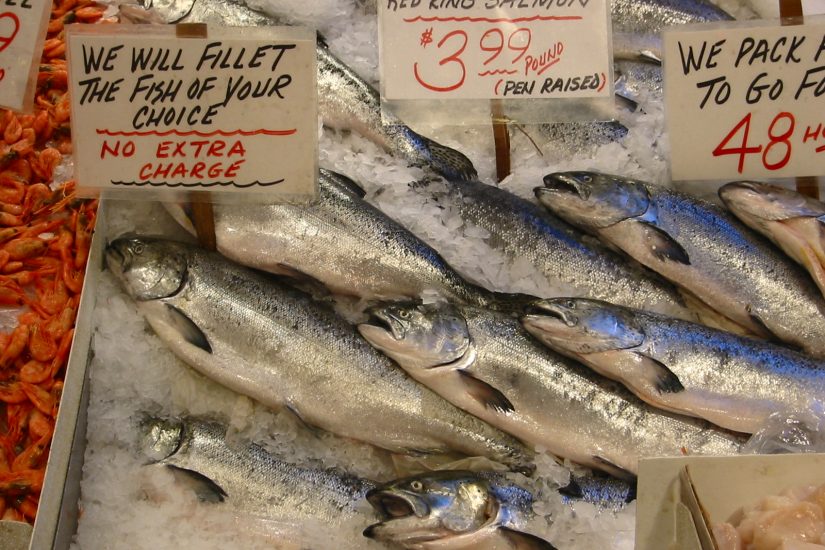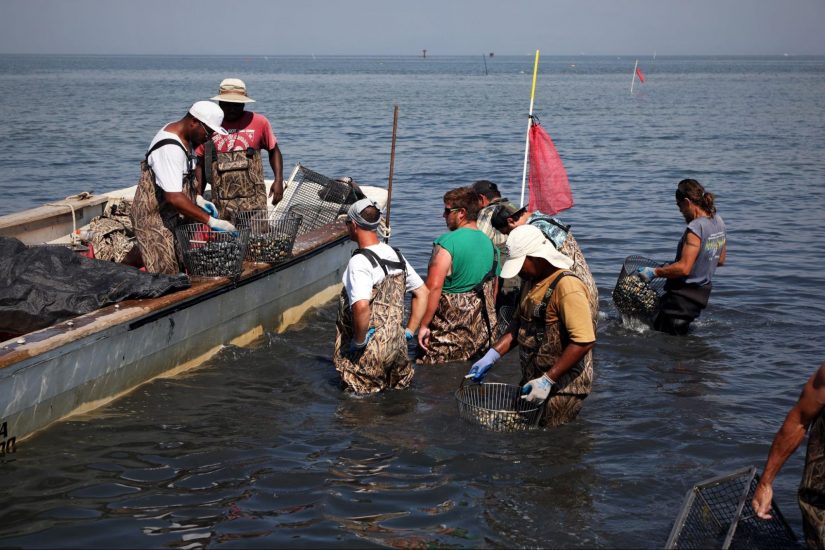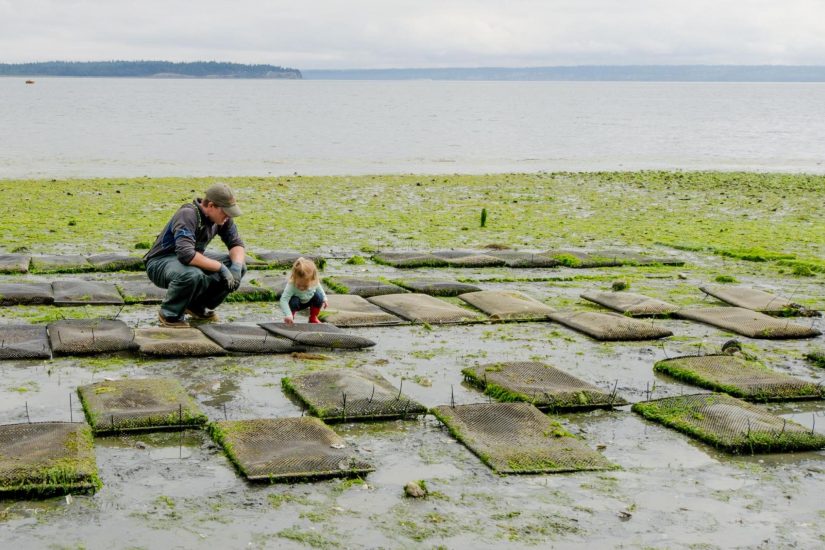Contemporary History: Understanding the Racial Background within the United States Aquatic Food System
In the United States, researchers, managers, and producers often frame aquatic food production systems based on benefits to people. When describing the ecological dimensions, researchers might focus on the climate mitigating benefits of farming kelp, or how shellfish aquaculture can improve water quality by putting more filter feeders into the water. Policymakers seeking to increase aquatic food production might tout the nutritional benefits of aquatic food-based diets, from overcoming valuable micronutrient deficiencies to having the potential to account for 13.7% of the global protein intake. One way our aquatic food systems haven’t been often described, however, is by the people themselves – who eats aquatic food, who produces them, and who reaps those benefits. Today, a conversation is starting to unfold among the same researchers, managers, and producers, beginning to identify the racial inequities pervasive throughout the system. Individual stigmas drive power dynamics amongst people, which catalyze injustices and inform how the system is structured.
This article will begin to unravel the thread of racial inequity in the United States aquatic food system. First, the complexities and multiple tiers of racism will be generally explored to describe how they appear throughout the institutions and systems of the United States. Following this, I’ll identify racial inequities within the history of and ongoing racism in coastal, freshwater, and marine/high sea fisheries. Finally, I’ll provide some insight and suggestions on how to address each level of racism and take action. This work is inspired by the Annual Racial Equity Habit-Building Challenge hosted by Food Solutions New England. Every April, this multi-racial network shares 21 days worth of resources, readings, and reflections to guide thinking around racial equity in broader food systems. Much like this challenge, this article is not a proposed solution for racial inequity, but rather a “pulse of focused energy” to catalyze action and change wherever one finds capacity.

How Experts Define Racial Inequity
Racial inequity might often be perceived as overt, singular, discriminatory interactions from one person to another based on the color of their skin. When these interpersonal interactions play out, whether in public, private, or through technological means, one person is made to feel excluded, wrong, or similarly inferior explicitly because of their race. However, race is socially constructed and has less to do with the color of a person’s skin and more to do with the systemic and institutional structures that have perpetuated the myth of superiority or inferiority due to genetics. Racism, therefore, doesn’t always exist as the overt (or discrete, in the case of microaggressions) interpersonal interactions, but runs much deeper. As described by the Multicultural Resource Center, different levels of racism exist, each operationalizing racial inequity at different scales and with different ramifications.
Internalized racism pervades the unconscious biases a person forms. This type of racial inequity guides how an individual interacts with their environment and responds to social situations. As social creatures, humans pick up cues from our surroundings which can form our convictions, values, norms, and opinions. This shapes our behavior whether or not we consciously recognize it. When we develop and retain certain myths regarding racial inequity – often, that Black, Indigenous, and other people of color are somehow inferior due to their race – these manifest in diverse and usually unintentional ways. Overcoming internalized racism requires recognizing the ways we have been socialized to perceive our environments, and choosing to undo this learning through meaningful, intentional steps of dismantling.
Internalized racism isn’t the only invisible dimension of racial inequity. Privilege, or the unearned advantages afforded to some people due to identities or social categories they fit in, can give people an edge in personal and professional situations. While theoretically all people share the same basic rights that are upheld and guaranteed to them by their governments, the distribution and allocation of these rights aren’t necessarily always equitable. Privilege and power are complicated further by individuals holding multiple identities, so while one identity may grant certain privileges, others may take those away. It is important to consider that privilege is not something earned. Often, it is reflective of a broader level of racism known as institutional racism. Under institutional racism, inequities not only exist on a personal level, but also on the level of societal systems and organizations. These institutions structure society, and when policies or regulations are passed that disproportionately affect some people over others on the basis of race, they create privilege and power – as well as marginalization, dispossession, and/or oppression.
The final, most all-encompassing level of racial inequity is systemic racism. While institutional racism covers the structures of society as they exist today, systemic racism includes temporal and cultural components, connecting racial inequities pervasive in the current social moment to the historic systems that enabled such inequities to transpire. In the United States, especially in our food system, institutional racism can be tied back to the introduction and utilization of slave labor, paired with the displacement of Indigenous peoples from their lands. Recognizing that inequities were carefully embedded within the foundations of the United States helps us to accomplish two things: to realize that racial inequity today is not the result of a broken system but a deliberately designed structure; and to rewrite these parts of the story back into the dominant narrative, as a step of learning, dismantling, and liberating ourselves from the cycle of relentless injustice.
Racial inequity is complex, fluid, and ever-changing, as is our understanding of how to define it and how it operates in our country. While this article does not seek to explicitly support or deny the many faces of racism or their prevalence in society today, many articles, books, and other resources are available discussing these matters in more detail. The rest of this article will illuminate the complexities of racism, and will serve to explain and disentangling the types of racial inequity in United States aquatic food production, from the internalized biases that inform management decisions up to regulatory agencies themselves.

Racial Inequity in United States Aquatic Foods
Unraveling the thread of racial inequity prevalent in aquatic food production today begins with recognizing the legacy of fishers, farmers, and foragers of color that comprise our country’s foundation. At the earliest inception of the seafood business in the United States, it was Black oyster collectors and processors who brought about the slimy shellfish’s rise to culinary fame. All along the East coast in the 1800s, from the oyster king of New York to the bustling oyster industry of New Orleans and many states in between, oyster production was dominated by Black folks. Across mudflats and other viable shellfish habitats, these Black oyster collectors would bag the shellfish and sell them for consumption. Over time, however, the availability of shellfish on these once abundant oyster beds and reefs began to decline due to overharvesting and waterborne disease. In places like Virginia and Maryland, where shellfish production once totaled nearly 25 million pounds, the 1970s and 80s saw only 250,000 pounds produced, demonstrating a clear decline in native shellfish populations. Regulations like catch limits were implemented, but they were slow to conserve the shelled intertidal creatures. In response, shellfish production began to transition away from the collection of wild caught clams, mussels, and oysters towards aquaculture, the curated rearing and farming of different economically valuable species.
Today, many oysters on the market are the product of shellfish farming operations rather than wild collection. However, because the transition towards aquaculture has been cautious and slow in many regions of the world, and it follows historic land loss experienced by Black Americans through policies like eminent domain, the presence of Black fishers and farmers within oyster production has been lost to time. Oyster growers today recognize the lack of Black representation within the industry, especially among lease owners and permit holders who lead shellfish growing operations. In some areas of the Southeastern United States, Black oyster growers are reclaiming their heritage, managing their own oyster farms and putting Black-grown half shells back on the menu. But more must be done to recognize the erasure of this history within shellfish production, and the systemic racism that allowed such marginalization, dispossession, and the subsequent loss of legacy to occur in the first place.
Systemic and institutional racial inequities in the aquatic food system exist not only in the erasure of Black, Indigenous, and other communities of color (BIPOC) from its history, but also in the decision, policies, and practices of different fisheries today. In originally determining what freshwater fish species were valuable enough to be the target of conservation efforts, researchers from UC Davis argue that the historic White, male-dominated fisheries sciences led to a skewed prioritization of what fish were considered valuable. Operating within the lens of colonial preferences, economically valuable species were better protected than “rough fish,” which often included food fish species for underrepresented groups like Black, Indigenous, and other communities of color, in addition to immigrants. Just as BIPOC communities were erased through systemic efforts in the establishment of the United States, so too were they omitted from decisions on protecting different food systems. The species depletion and loss of subsistence from this decision is a direct example of systemic racism within freshwater fisheries. Today, management continues to neglect diverse fishes with low estimated value, which the UC Davis researchers argue reflects a lack of representation and meaningful recognition of BIPOC individuals within the fisheries and practices of freshwater fisheries today.
Racial inequities in marine fisheries exist in the form of the labor exploitations and abysmal working conditions used to meet the international demand for seafood. Sometimes called a form of “modern day slavery,” these exploitations target migrant workers and people of color disproportionately, leading to an institutionalized racial inequity which is exeedingly difficult to understand and address. While the use of coerced labor and human trafficking in United States fisheries is not well-investigated, our reliance on imported seafood means that some of the crustaceans and fish lining our store shelves may come from these unfair practices. To attempt to track and reveal the use of exploited migrant labor in fishery supply chains, Monterey Bay Aquarium’s Seafood Watch Program (which used to only report on the sustainability) now includes a Seafood Slavery Risk Tool which assigns ratings to different fisheries depending on their reported regulation and enforcement of equitable labor practices. Policy and research institutes like the Center for American Progress have made other recommendations to tackle the racial inequities in our sea-food system, like situating labor abuses within the managerial jurisdiction of illegal, unreported, and unregulated fishing and developing technology to aid in the enforcement of labor regulations.

Moving Forward
Learning about what racial inequity is, how it is internalized and externalized in our society, and what it looks like in the United States aquatic food system is one large step towards creating a more equitable, inclusive industry. However, this article highlights only a few of the diverse, plentiful, and some still unresearched, unrecognized, unearthed, or unknown stories that shape seafood in our country. Unlearning internalized stereotypes, recognizing power and privilege, and witnessing systemic and institutionalized racism is a constant, ongoing process which doesn’t ever stop. It is critical to remember that our choices cannot be hypothetical or internal, but that change is grounded in action and not just metaphorical commitments. This then begs the large, looming, and seemingly insurmountable question: where do we go from here?
“Unlearning internalized stereotypes, recognizing power and privilege, and witnessing systemic and institutionalized racism is a constant, ongoing process which doesn’t ever stop.”
One of the first steps is continuing to read, listen, and pay attention to the narratives that have been omitted from the history of fishing as we know it. There are many ways to accomplish this, including looking for the people already doing the work. Podcasts like the Bivalve Trail and blog posts from organizations like the Indigenous Aquaculture Collaborative Network tell the tales of Black and Indigenous individuals and communities who have been involved in seafood since the very beginning. In addition to learning, the process of healing means actively dismantling the structures of racial inequity that continue today. This begins by considering where you are, whether a student, someone who works in the environmental field, or a passionate and ardent supporter of racial equity more broadly. What kind of impact can you make?
As someone working within a sea-food system or related field, steps can include moving towards organizational commitments to racial equity, like those held by the North American Marine Alliance. It could also mean supporting and uplifting organizations seeking to increase representation within the system, like Minorities in Aquaculture. As an individual outside of the aquatic food system, this can mean joining local coalitions or movements rallying around food justice and equity. It could also include vocalizing support for broader initiatives for a more inclusive system, like rallying for racial equity in the upcoming National Seafood Council. Whatever form racial equity in action takes for you, it is a matter of persevering, of learning and unlearning, and mobilizing for a more inclusive aquatic food system for all people in the United States.